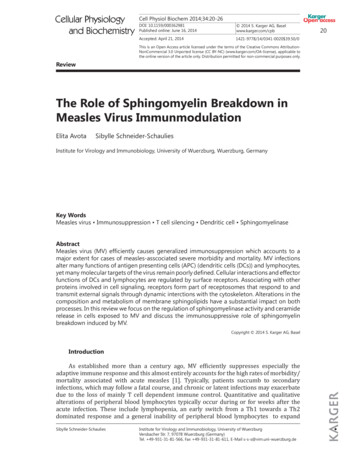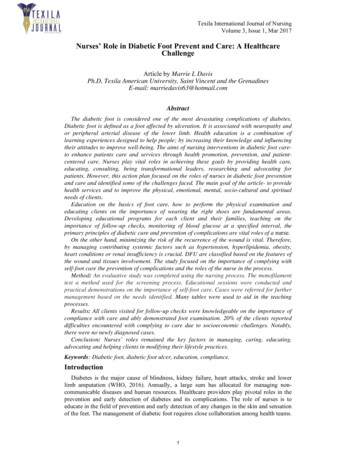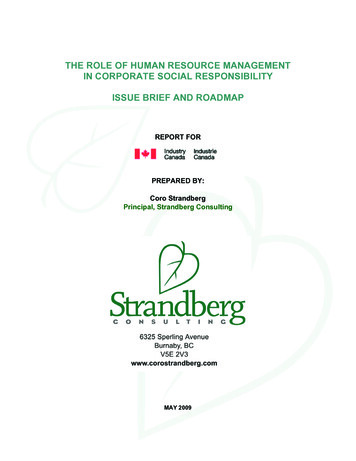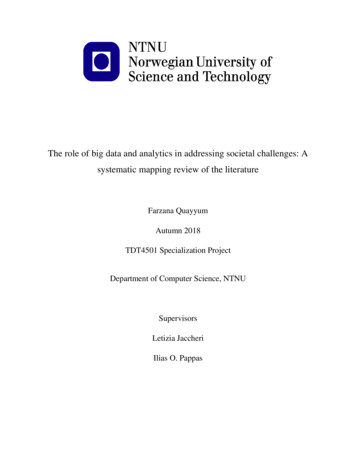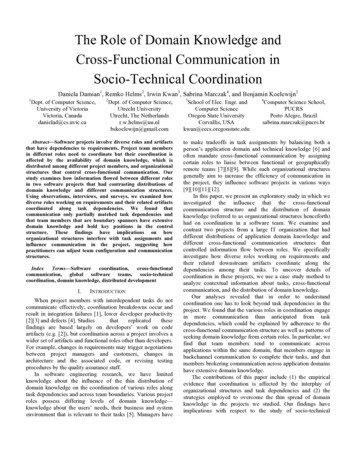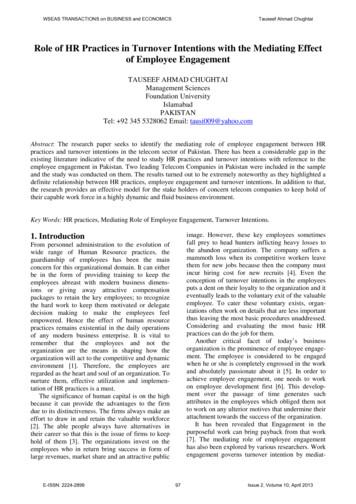
Transcription
WSEAS TRANSACTIONS on BUSINESS and ECONOMICSTauseef Ahmad ChughtaiRole of HR Practices in Turnover Intentions with the Mediating Effectof Employee EngagementTAUSEEF AHMAD CHUGHTAIManagement SciencesFoundation UniversityIslamabadPAKISTANTel: 92 345 5328062 Email: tausi009@yahoo.comAbstract: The research paper seeks to identify the mediating role of employee engagement between HRpractices and turnover intentions in the telecom sector of Pakistan. There has been a considerable gap in theexisting literature indicative of the need to study HR practices and turnover intentions with reference to theemployee engagement in Pakistan. Two leading Telecom Companies in Pakistan were included in the sampleand the study was conducted on them. The results turned out to be extremely noteworthy as they highlighted adefinite relationship between HR practices, employee engagement and turnover intentions. In addition to that,the research provides an effective model for the stake holders of concern telecom companies to keep hold oftheir capable work force in a highly dynamic and fluid business environment.Key Words: HR practices, Mediating Role of Employee Engagement, Turnover Intentions.image. However, these key employees sometimesfall prey to head hunters inflicting heavy losses tothe abandon organization. The company suffers amammoth loss when its competitive workers leavethem for new jobs because then the company mustincur hiring cost for new recruits [4]. Even theconception of turnover intentions in the employeesputs a dent on their loyalty to the organization and iteventually leads to the voluntary exit of the valuableemployee. To cater these voluntary exists, organizations often work on details that are less importantthus leaving the most basic procedures unaddressed.Considering and evaluating the most basic HRpractices can do the job for them.Another critical facet of today’s businessorganization is the prominence of employee engagement. The employee is considered to be engagedwhen he or she is completely engrossed in the workand absolutely passionate about it [5]. In order toachieve employee engagement, one needs to workon employee development first [6]. This development over the passage of time generates suchattributes in the employees which obliged them notto work on any ulterior motives that undermine theirattachment towards the success of the organization.It has been revealed that Engagement in thepurposeful work can bring payback from that work[7]. The mediating role of employee engagementhas also been explored by various researchers. Workengagement governs turnover intention by mediat-1. IntroductionFrom personnel administration to the evolution ofwide range of Human Resource practices, theguardianship of employees has been the mainconcern for this organizational domain. It can eitherbe in the form of providing training to keep theemployees abreast with modern business dimensions or giving away attractive compensationpackages to retain the key employees; to recognizethe hard work to keep them motivated or delegatedecision making to make the employees feelempowered. Hence the effect of human resourcepractices remains existential in the daily operationsof any modern business enterprise. It is vital toremember that the employees and not theorganization are the means in shaping how theorganization will act to the competitive and dynamicenvironment [1]. Therefore, the employees areregarded as the heart and soul of an organization. Tonurture them, effective utilization and implementation of HR practices is a must.The significance of human capital is on the highbecause it can provide the advantages to the firmdue to its distinctiveness. The firms always make aneffort to draw in and retain the valuable workforce[2]. The able people always have alternatives intheir career so that this is the issue of firms to keephold of them [3]. The organizations invest on theemployees who in return bring success in form oflarge revenues, market share and an attractive publicE-ISSN: 2224-289997Issue 2, Volume 10, April 2013
WSEAS TRANSACTIONS on BUSINESS and ECONOMICSTauseef Ahmad Chughtaiing the link with job resources [8]. Employeeengagement acts as a mediator in the link betweenperceived HRM practices and Extra-role behaviour& Withdrawal behaviour [9]. Therefore the implication of employee engagement in any profit or nonprofit organization can’t be ruled out.absenting themselves during their jobs [10].Employees will feel engaged when they unearthenthusiasm and personal sense in their work, getpositive social support and work in an environmentthat is well-organized and proficient [11].Human resource managers endeavor to attainemployee engagement by giving rewards, recognition of employee’s effort, harnessing relationships,giving opportunities to excel, inducing leadershipqualities and providing a friendly environment [12].HR practitioners accept as true that the engagementbasically deals with the fact that how an employeethinks about the job and in what manner the organization deals with him. Actually it’s the emotionsthat result in the success of the organization [13].The effective use of HR can enable theorganization to bring engagement and consequentlycultivate motivation, output and offcourse retention.The intensity of engagement reveals whether theworkforce will stay and remain productive or theywill relinquish and become part of the competitors[14].The turnover intention is the last stride whichultimately results in the renouncement of the job[15]. Engagement is negatively associated with turnover intentions which mean that an engagedemployee would never think about leaving theorganization [16]. Work engagement is directly andpositively related with employees’ job satisfactionand it has a negative relationship with employeeturnover intentions [17]. The more engaged employees are, the longer they would remain committedand such employees also stay longer with theorganization [18]. The engagement of employee isin fact a valuable gauge to measure the connectionof an employee to the place of work [19].In order to increase the attraction and retention ofvaluable workforce, that policy should beformulated that allow employees to have flexiblework schedules, result oriented remuneration, inputin decision making, career advancement along withthe exigent work assignments is a must [20].Engagement also leads to higher levels ofidentification with a job which may make it difficultfor employees to detach themselves from the roleand leave the organization [21, 22]. The research onnurses of Malaysia revealed that with effective useof HR practices, the level of intentions to leave thejob is considerably reduced [23]. Many researchersalso come up with the findings that work practiceslike the employee participation, employeeengagement and total quality management musteffectively be incorporated on day to day basis asthey result in lower turnover intentions andincreased satisfaction of the employees [24, 25, 26].1.1 Problem StatementConsidering the aforesaid discussion, the researcherhas decided to study the mediating role of employeeengagement on the effective use of HR practices andturnover intentions in the Telecom Sector ofPakistan.1.2 Originality of the StudyThe research domain that is the employeeengagement and its mediating effect on HRpractices and turnover intentions particularly in theTelecom Sector of Pakistan is yet to be researched.In the context of Pakistan telecom sector, thisresearch will fill the current void and notably makea contribution in the body of knowledge.1.3 Applied AspectsRetention of engaged workforce is imperative forevery organization as it brings success even in themost receding business conditions. Findings of thestudy will facilitate the HR managers and top brassof the concern Pakistani telecom companies in termsof making the effective use of most common HRpractices in order to keep hold of their human talentwhile creating a vibrant and result orientedenvironment for engaging their employees.1.4 Objectives of the study1.2.3.To study the level of basic HR practices that ispracticed by the Telecom sector of Pakistan.To study the turnover intentions in samepopulation.To determine whether employee engagementmediates the relationship between basic HRpractices (independent variable) and turnoverintentions (dependent variable).2. Literature ReviewThe term Engagement was originally developed byKahn. Employee engagement focalizes on how thepsychological happenings at work and workcontexts forge the process of people presenting andE-ISSN: 2224-289998Issue 2, Volume 10, April 2013
WSEAS TRANSACTIONS on BUSINESS and ECONOMICSTauseef Ahmad Chughtai2.1 Proposed Research Framework2.1.1 Foundation for Research FrameworkThis research article is based on the aboveframework that has been created after a thoroughliterature review. For the independent variable i.e.HR practices, five basic dimensions powerment & work life policies) have beenincluded considering the holistic outlook of HRpractices in Pakistan. Employee Engagement hasbeen used as a mediating variable which mediatesthe link between HR Practices and the TurnoverIntentions i.e. the dependent variable. This researcharticle uses Social Exchange Theory (SET) forcorroborating the research framework. It is referredas a reciprocally benefitted exchange between twoparties which is guided by certain rules which leadsto a trustworthy relationship [27]. Therefore,employees who receive any sort of benefit,remuneration or reward from their organization feelduty-bound to respond in a way that is beneficial tothe organization. The possible benefits can be thedevelopmental HRM practices [28].3.2 PopulationThe universe for this research consists of twoleading telecom companies in Pakistan i.e. Mobilinkand Telenor Pakistan. Both the telecommunicationservice providers have made prolific progress overthe years as they appear to be market leaders.Mobilink holds the market share of more than 30%alongside Telenor with 25%.3.3 Sampling ProcedureHr Managers, Executives and Admin related officersare included in the sample for this research. Simplerandom sampling has been utilized in order to avoidany biasness. A total of 105 employees(respondents) from each company were drawn that’smake a total of 210 respondents.3.4 Tools for data collectionA questionnaire was being used for themeasurement of all the variables involved in thestudy. A 6-item scale for competence development,6-item scale for recognition, 3-item scale forempowerment, 5-item scale for pay structure and 5item scale for work-life policies were adopted [29,30, 31, 32]. Turnover intentions were measuredusing a 4-item scale [33]. Lastly, the employeeengagement was measured on a 12-item scale [34].A five point Likert scale was being utilized for theexamination.3. Methodology3.1 Hypothesis Generation:Following hypothesis have been generated incontext with the theoretical framework.H1: The effective use of basic HR practicesleads to low level of turnover intentions.H2: The effective use of basic HR practicesleads to high level of employee engagement.H3: High level of employee engagement leads tolow level of turnover intentions.H4: The relationship between HR practices andturnover intentions gets mediated by employeeengagement.E-ISSN: 2224-28993.5 Reliability of the InstrumentsAlpha Reliability values were calculated for all thevariables involved and they are mentioned in thetable below.99Issue 2, Volume 10, April 2013
WSEAS TRANSACTIONS on BUSINESS and ECONOMICSTauseef Ahmad Chughtai.862, it is disclosed that 86.2% variation in turnoverintentions is due to HR practices and only 13.8% isdue to some other factors. The P value is 0.000 i.e.less than (0.05) which means that Hypothesis 1 issupported.H2: The effective use of basic HR practicesleads to high level of employee engagement.Table 1: Reliability of the InstrumentsCronbach’sAlphaNo. ofItemsCompetence Development.8746Pay Structure.8595Recognition.8756Empowerment.8383Work Life Policies.8465Turnover Intentions.9254Employee Engagement.96112VariableTable 4: Results regression analysis(HR practices & Employee Engagement)2rR2Adjusted RHR practices.899.808.807BetaFP value.899665.2890.0003.6 Demographic Profile of the RespondentsHR practicesDemographic profile of thementioned in the table below.Dependent Variable: Employee EngagementrespondentsisIn table 4, r is .899 that is representing a strongrelationship between HR practices and employeeengagement. R2 is .808 which means that 80.8%variation in employee engagement is because of HRpractices. The P value is 0.000 (0.05) resulting inthe acceptance of hypothesis 2.H3: High level of employee engagement leadsto low level of turnover intentions.Table 2: Demographic Profile of the RespondentsGenderMaleFemaleTotalAge Group24 to 3031 to 3738 to 44TotalMarital 2210Frequency5110059210Frequency13575210Table 5: Results regression analysis(Employee Engagement & Turnover Intentions)2rR2Adj. REmployee Engagement.920.846BetaFEmployee Engagement-.920866.187Dependent Variable: Turnover Intentions4. Data AnalysisIn table 5, r is .920 that is the indicative of strongcorrelation between employee engagement andturnover intentions. R2 is .846 which shows that84.6% variation in turnover intentions is due toemployee engagement. The P value is 0.000 (0.05) enabling us to accept hypothesis 3.H4: The relationship between HR practices andturnover intentions gets mediated by employeeengagement.Linear regression was carried out for the testing ofthe hypothesis involved in the research. For testingof mediation, Baron and Kenny test was beingapplied [35].H1: The effective use of basic HR practicesleads to low level of turnover intentions.Table 3: Results regression analysis(HR practices & Turnover Intentions)2rR2Adjusted RHR practices.928
Retention of engaged workforce is imperative for every organization as it brings success even in the most receding business conditions. Findings of the study will facilitate the HR managers and top brass of the concern Pakistani telecom companies in terms of making the effective use of most common HR practices in order to keep hold of their human talent while creating a vibrant and result .

